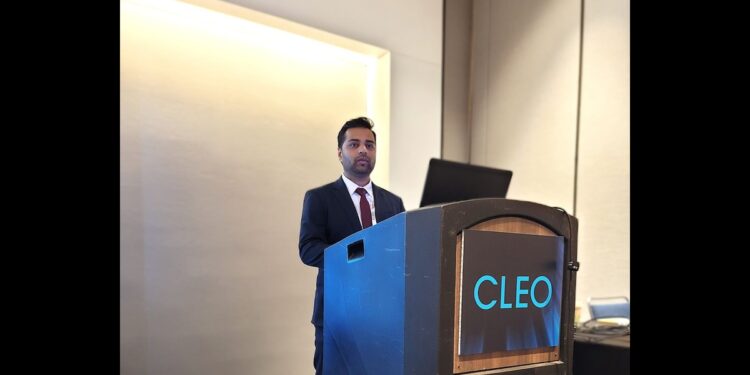
Written by Anne Schulze
Breakthrough developments in detector technology are reshaping the photonics industry, enabling innovations across diverse sectors. With over 12 years of expertise in photonics and detector technology, Arshey Patadia has established himself as an influential figure in the field. His contributions span leading advances in range finding and eye-safe LiDAR to developing photonics-based solutions for quantum key decryption and space communications, demonstrating technical skill and strategic vision.
Q: How do you envision the future of photonics and detector technology?
Patadia: “The future of photonics is about redefining the limits of possibility, and that’s precisely what we’re doing. Our new designs will unlock applications that were once deemed impossible. We’re at an extraordinary moment where materials science, advanced fabrication, and computational power converge to enable devices that once seemed impossible.”
Q: What recent breakthroughs in photodetector technology excite you most?
Patadia: “Our latest designs focus on dramatically increasing the sensitivity of photodetectors, allowing them to detect the faintest signals in even the most challenging environments. We’ve expanded the detectors’ wavelength range—from ultraviolet to far-infrared—making them more versatile than ever by incorporating next-generation materials and advanced fabrication techniques.”
Q: How are these innovations impacting different industries?
Patadia: “In the robotics and automotive sector, our eye-safe LiDAR detectors could be a game-changer, particularly for autonomous systems. In healthcare, our high-sensitivity photodetectors are transforming medical imaging and diagnostics. They can be used for methane emission imaging and forest cover evaluation in the environmental sector. The applications extend to urban and landscape monitoring, aerospace, photonic-based computation, and beyond.”
Q: What unique challenges have you encountered in developing these technologies?
Patadia: “One of our biggest challenges has been balancing high performance with practical implementation. We’re not just creating cutting-edge technology; we’re making it scalable and accessible for widespread use. This requires innovative approaches to both design and manufacturing that leverage existing CMOS-based semiconductor manufacturing methods and integrate them with III-V based compound semiconductor materials.”
Q: Can you elaborate on some specific applications of your detector technology?
Patadia: “We’ve developed detectors for various critical applications, from mapping the Amazon rainforest to enabling space-based methane detection. Our single-photon detector technology is also used in advanced particle physics experiments and quantum computing applications. Some standard detectors originally used in range finding have found new applications in autonomous systems and agriculture. Each application presents unique challenges and opportunities for innovation.”
Q: What drives your passion for innovation in photonics?
Patadia: “The ability to push boundaries and make a real impact fuels me. Whether saving lives, protecting our planet, or enabling scientific discoveries we haven’t yet imagined, this work is about shaping the future. And that’s a responsibility I take very seriously.”
Q: Looking ahead, what developments do you anticipate in the next few years?
Patadia: “We’re seeing incredible potential in the convergence of photonics with AI and quantum technologies. I expect significant breakthroughs in areas like quantum computing, environmental monitoring, and medical diagnostics. Another sector that truly feels ready for explosive growth is photonics-based computing. As Moore's Law is challenged by continually reducing node sizes, photonics, and photonics-based chips will become integral in the next-generation computing and speeds needed for AI engines, deep learning, and neural networks. The possibilities are truly limitless.”
Illuminating Tomorrow’s Technologies
As our conversation with Arshey Patadia concludes, it’s clear that the future of photonics holds promise. His work advancing photodetector and emitter technology represents more than just technical innovation—it’s about shaping the future of countless industries and applications. As the global photonics market and its applications continue to grow, projected to exceed $1 trillion by 2030, his contributions will be crucial in driving the industry forward.
Patadia mentions, “By leveraging photons instead of electrons, silicon photonics promises faster, more energy-efficient systems capable of reshaping the future of AI and deep learning. Photonic systems operate at speeds far beyond traditional electronic chips, with switching capabilities exceeding 100 GHz and data transmission rates surpassing 2 Tb/s on a single channel. This represents a 200x improvement in energy efficiency, drastically reducing power requirements for data-heavy applications such as AI and machine learning. Moreover, matrix multiplications—core to neural networks—could transition to constant-time processing, enabling 1000×1000 matrix calculations in mere picoseconds."
Patadia also highlights the advantages of such technology. He mentions, "Photonics-based interconnects do not generate as much heat as traditional copper/metal-based interconnects. While current real-world products demonstrate unparalleled speeds, like 400G transceivers or 2 Tb/s chip-to-chip links, the industry is at least 5-10 years away from achieving mass production and affordability." Patadia's innovations in the field of photonics are helping form the growth trajectory of silicon photonics and heralds a new era of Moore's Law, unlocking unparalleled computational possibilities.
Through his leadership and strategic approach, Patadia is meeting current industry demands and helping to usher in a new age of photonic possibilities . From enabling more accurate medical diagnoses to advancing space exploration, his work demonstrates how pushing the boundaries of detector and emitter technology can lead to transformative solutions for some of society’s most pressing challenges.
As industries worldwide increasingly rely on advanced photodetectors, Patadia’s vision and expertise continue to light the way forward, promising a future where the possibilities of photonic technology are limited only by our imagination.
The post Arshey Patadia on Advancing Photonics: A Technology Leader’s Perspective appeared first on New York Tech Media.
© 2025 Benzinga.com. Benzinga does not provide investment advice. All rights reserved.
Trade confidently with insights and alerts from analyst ratings, free reports and breaking news that affects the stocks you care about.